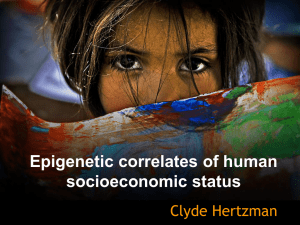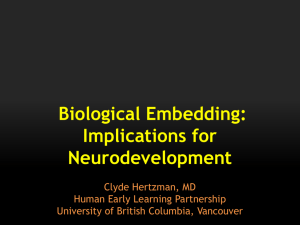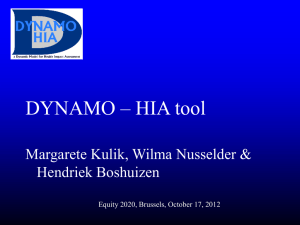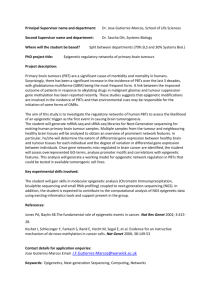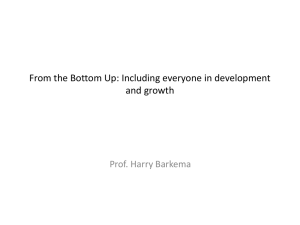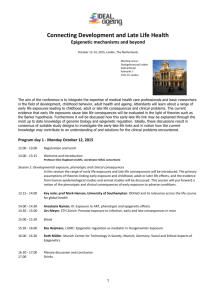Early Human Development as a Social Determinant of
advertisement
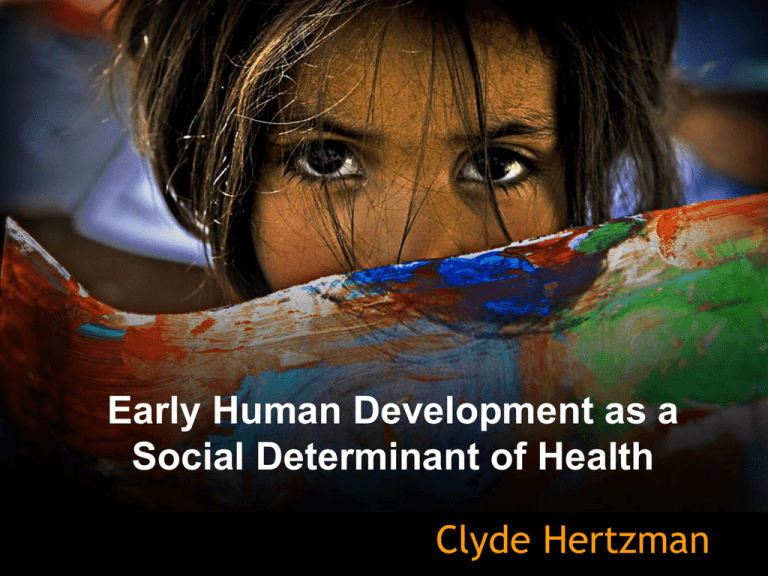
Early Human Development as a Social Determinant of Health Clyde Hertzman Gradient in all Cause Mortality: UK Whitehall Study CHD Mortality - UK Whitehall Study The Challenge of the Gradient • ubiquitous in wealthy and majority world countries by income, education, or occupation • cuts across a wide range of disease processes • not explained by traditional risk factors • replicates itself on new conditions as they emerge • occurs among males and females • ‘flattens up’ • begins life as gradient in ‘developmental health’ % Vulnerable Canada: % vulnerable by SES Source: NLSCY/UEY 1999-2000; EDI 1999-2000 Sensitive Periods in Early Brain Development Pre-school years High School years Numbers Peer social skills Language Symbol Habitual ways of responding Emotional control Vision Hearing Low 0 1 2 3 4 Years 5 6 7 Graph developed by Council for Early Child Development (ref: Nash, 1997; Early Years Study, 1999; Shonkoff, 2000.) What Influences Early Child Development? The experiences children have in the environments where they grow up, live and learn. Life Course Problems Related to Early Life 2nd Decade • School Failure 3rd/4th Decade • Obesity 5th/6th Decade Old Age • Coronary Heart • Premature Disease Aging • Teen Pregnancy • Elevated Blood Pressure • Diabetes • Criminality • Depression • Memory Loss Two responses • understanding ECD at the level of the population • understanding the developmental biology of the gradient Early Development Instrument • 104 items • Extensive validity and reliability data from several countries • Not a test • Teacher at age 5 is respondent • Five developmental domains, with sixteen subdomains • A guide with explanations available What Does the EDI Measure? EDI is: -a population-based tool -a mobilisation tool -a monitoring tool EDI is not: -an individual assessment -a prescription for action -perfect What the maps reveal… • Large local area differences in the proportion of developmentally vulnerable children • The high proportion of avoidable vulnerability • The degree to which socioeconomic context explains and does not explain variations in early development • Which communities are doing better or worse than predicted…….to set up the study of ‘why’ • Change over time • Rationale for programs and policies Two responses • understanding ECD at the level of the population • understanding the developmental biology of the gradient Hypothesis: Biological embedding Biological embedding occurs when • experience gets under the skin and alters human biodevelopment; • systematic differences in experience in different social environments lead to different biodevelopmental states; • the differences are stable and long-term; they influence health, well-being, learning, and/or behaviour over the life course. Archeology of Biological Embedding Quic kTime™ and a GIF dec ompres sor are needed to s ee this pic ture. Experience/Behavior Neural Circuitry Cell/Synapse Gene Expression Shallow Archeology Candidate Systems • HPA axis --- cortisol • ANS system --- epinephrine/ne • Prefrontal cortex • Social affiliation --amygdala/locus cereleus • Immune function -- the ‘peripheral brain’ Candidate System: Prefrontal Cortex SES Differences by School Age Deep Archeology ‘Social Epigenesis’ and other processes that can influence gene expression. Biological Embedding: The ‘MeaneySzyf Paradigm’ • rat pups from high and low licking/suckling mothers cross-fostered to remove genetic effect • differential qualities of nurturance occurs during sensitive period of brain development • differential nurturance leads to epigenetic modification of key DNA regulatory loci through methylation The ‘Meaney-Szyf Paradigm’ (cont’d) • epigenetic modification leads to lifelong change in HPA axis response to stress • this change affects learning and behaviour across the rat life course • inter-generational transmission (high licked female pups become high licking mothers, and vice versa) The Scenario If early experience really does ‘get under the skin’ to influence brain and biological development through epigenetic processes, then: • similar environments & experiences should leave a consistent set of epigenetic ‘marks’ on different populations, and/or create great opportunities for understanding gene-environment-epigenetic interplay. • the variation in epigenetic marks in children from diverse environments (& experiences) globally should teach us a great deal about biological embedding. SES, Life Course and Epigenesis: An Hypothesis Generating Study • The opportunity: a large birth cohort (>17,000 at birth), with >4000 phenotypic variables collected at birth and 7 follow-ups, with fresh lymphocytes collected at age 45. • The goal: to identify a full range of gene loci where experience may have become ‘biologically embedded’ through methylation. • Done to date: examined >20,000 regulatory regions of 40 cohort members, sampled according to a factorial design, based upon extremes of SES in childhood and adulthood. So far: • 1252 loci differentially methylated according to childhood SES • Approx. 4000 loci differentially methylated according to retrospective reports of abuse in childhood Hypothetical Patterns of Influence Exposure Endophenotype Abuse Mid- Brain affiliation/attachment PFC executive function/ impulsivity Epigenome Phenotype Health behaviors Mental health HPA stress response Chronic diseases Exposure (Prenatal) Maternal Smoking Epigenome Biochemical Phenotype /Biophysical Pathway Exposure Specific Pathways Common Pathways Childhood Abuse Childhood SES Exposure Specific Pathways Exposure Specific Pathways Outcome(s) Where to from there? The Wisconsin Study of Families and Work The BC GECKO Study: ‘On and Off-diagonal children’ in ‘On and Off-diagonal neighbourhoods’ Developing country studies www.earlylearning.ubc.ca
